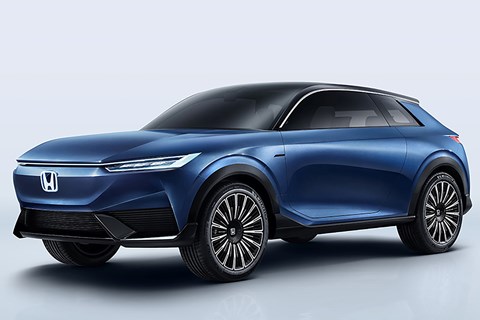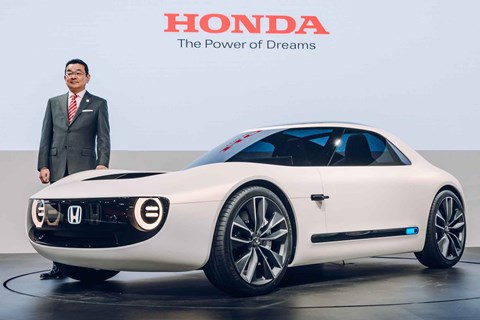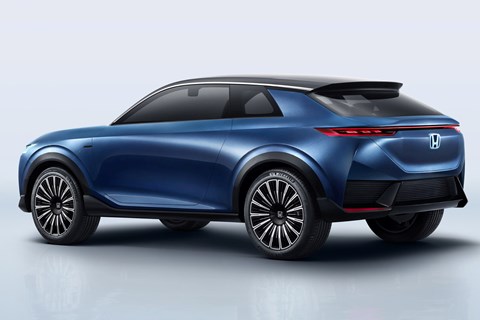► Honda drops enormous hint about new sports car
► Fresh line-up due in 2030 will includes ‘at least’ two electric sports cars
► First new electric cars to hit the market in 2024
Honda looks set to stun the world with its first electric sports car later this year in celebration of its 75th anniversary.
Industry insiders at the company have hinted at the timeline to CAR, referencing the S2000, which was released for the company’s 50th birthday.
The car will sit on Honda’s latest e:n electric architecture, which will debut in front-wheel drive specification (e:n f) in the shape of the Honda e:Ny1, and will also come with all-wheel drive (e:n W) and rear-wheel drive (unconfirmed name of e:n R) variants.
By 2030 the firm is set to reveal 30 new electric cars based on this architecture. Out of those 30, Honda will build – at least – two sports cars. One being an NSX successor, and the other a new GT.
Intriguingly, the new sports car could wear Type R badges too, becoming only the second non-front-wheel drive car to sport the red moniker after the NSX Type-R.
Honda technical consultant, Kotaro Yamamoto, told CAR: ‘Type R stands for racing. It’s pleasure transported. An electric car can deliver this, and a Type R is not obliged to use a combustion engine. Even in a fully electric society, there will still be Type Rs delivering ultimate driving pleasure.’
The firm is remaining tight-lipped about power figures, technical specifications and prices. But Head of Automobiles for Honda UK, Rebecca Adamson, said: ‘While we cannot compete with Chinese manufacturers on price, we have 75 years of engineering experience.’ Which to us sounds like a hint that it’ll be more expensive than an MG Cyberster.
How Honda will electrify its range
Honda has a host of region-specific electric vehicles planned for launch soon. In 2024, the brand will unveil a pair of larger electric vehicles for North American buyers (previewed below) and a reasonably priced miniature electric commercial vehicle for the Japanese market.
But that’s just the beginning. Once its dinky electric van has gained a foothold, Honda will launch a range of mini EVs for private Japanese buyers. Honda also plans to launch 10 new electric cars in China by 2027, some of which will be built at its new Guangzhou plant.

The firm is working on driving down the cost of its electric vehicles, too. In 2026, Honda will roll out its new e: Architecture which it says will produce EVs “with a cost and range that will be as competitive as gasoline-powered vehicles.” The platform is being co-developed with General Motors, and North America will be the first region to receive the new cars.
Once the e: Architecture goes online, Honda’s electric portfolio will explode with the mighty power of a faulty lithium-ion battery pack. The firm will launch 30 new electric vehicles by 2030, at an annual production volume of two million units. Its new range will include everything from tiny commercial vehicles to family SUVs and flagship sports cars.
What is Electric Vision?
Electric Vision is the official name attached to Honda’s enterprising electrification scheme. The strategy includes hybrids (like the Honda Jazz and Honda CR-V), but Honda has plans for expanding its BEV (battery-electric vehicle) line-up beyond the Honda e supermini.
Honda has teamed up with a range of manufacturers to accelerate its transition away from combustion cars. We’ve already mentioned the company’s partnership with General Motors, but Honda will also help Sony build its upcoming Vision-S SUV, while the Chinese battery manufacturer CATL will supply cells for Honda’s cars.
And Honda’s hungry. The brand originally intended to deliver the initial stages of its electrification strategy by 2025, but the company brought that deadline forward by three years. Now, Honda will have six electrified vehicles on sale in Europe by the end of 2022, including the all-new Civic hybrid.
By 2050 Honda also aims to halve the CO2 output of its new cars compared to 2001 figures, slashing their emissions by 80-90% overall.
A guide to Honda electric cars

The first Honda electric car. The E combines retro-looks with cutting edge tech to make a charming little supermini that prioritises style over a long battery range. Official WLTP range is between 125-137 miles depending on which version you buy. But expect to see figures as low as 100 miles in cold weather.
It’s comparatively more expensive than other electric superminis (starting from £26,660), but it remains an EV we like a lot at CAR. It’s packed with cool tech including two 12.3-inch screens on the dashboard, camera mirrors and a three-point plug in the cabin to charge up your laptop on the go. It also has one of the most characterful interiors currently on sale and it’s a hoot to drive, too. Read our long-term test for our full assessment.

First showcased at the 2017 Tokyo Motor Show alongside the Urban EV Concept, the Sports EV concept appears to be edging ever closer to production. A patent registered in 2019 by Honda showcases a sleek sports car that shares more than a few design cues with the Honda e, most notably the retro-inspired headlights.
While it moves away from the overt 1960s styling of the concept shown in Tokyo, it will still sit on Honda’s BEV platform and will most likely use a more potent version of the powertrain found in the Honda e. Could it be a spiritual successor to the Honda S800? We’ll keep our fingers crossed.

The Honda SUV e:Concept was unveiled at the Beijing Motor Show in 2020. It will soon morph into a new, pure-electric crossover, sitting about the Honda e in the company’s line-up and becoming an EV alternative to the Honda HR-V hybrid.
We expect it’ll be based on the same underpinnings as the Honda e supermini, albeit it stretched out to accommodate the larger SUV body style. It’ll also likely inherit the e’s screen-filled interior and quirky rear-view cameras. We’re expecting a larger battery pack, too – the e’s tiny 35.5kWh battery might struggle to get the heavier SUV more than 100 miles.
e: Progress explained
e: Progress is a charging subscription service, exclusively for Honda’s electric car drivers. The company claims it can save buyers an average of £400 per year on charging costs by signing up to the service by taking advantage of low-cost off-peak energy tariffs and clever charge scheduling.
For a fee, Honda provides its EV drivers with an intelligent home wallbox charger which can automatically top up a car’s battery pack when electricity is cheaper. The brand partnered with Octopus energy for the project, latching on to its dynamic energy tariff. As an added benefit, Honda guarantees that all the energy used to charge its electric cars using this scheme will come from renewable sources.